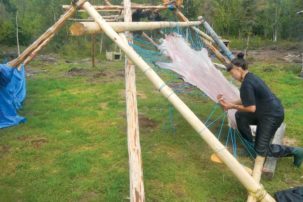Our editors’ weekly roundup of art news.
This week, the National Gallery of Canada gave a press preview of its new Canadian and Indigenous Galleries, due to open to the public June 15. As a result, some images are now available online of the updated collections displays. (Previously, historical Indigenous art was shown separately from historical Canadian art.) National Gallery director Marc Mayer told the CBC that “It presents Canadian and Indigenous art, side by side, telling two separate stories that may seem to converge in the present, but converging without assimilation.” The change is also noted by the CBC as the first major redesign at the gallery since opening at its current location on Sussex Drive in 1988. Watch for Canadian Art’s in-depth review of this exhibition in the coming weeks.
For the first time since it began in 2002, the shortlist for the Sobey Art Award, one of Canada’s largest art prizes, is made up of mostly women. In the past, at most only two out of the five shortlisted artists have been women; this year, four out of the five finalists are women. This year also doubled the number of Indigenous artists ever shortlisted for the award—at most, in the past, one of the finalists happened to be Indigenous; this year, it is two. The shortlisted artists this year are Ursula Johnson, Raymond Boisjoly, Jacynthe Carrier, Bridget Moser and Divya Mehra. The winner of the $50,000 first prize will be announced October 25 in Toronto.
The prospect of an enormous rubber duck floating around Ontario waterways has ruffled multiple feathers of late. First, members of the Ontario Conservative Party complained that the $120,000 the government was kicking into the plan in celebration of Canada 150 was a waste of taxpayer dollars. Then the studio of Dutch artist Florentijn Hofman issued a press release stating that the duck—owned and leased out by American businessperson Ryan Whaley—was a counterfeit of a rubber duck Hofman has been circulating at various points worldwide since 2007. Responding to questions in a CBC interview, Whaley stated, “The duck is public domain. That duck was actually created in the ’30s, not by Florentijn Hofman as he claims.” As of press time, the duck is still listed as one of the main attractions of Toronto’s Redpath Waterfront Festival on July 1 weekend.
This year’s Victor Martyn Lynch-Staunton Awards have been given for outstanding artistic achievement by Canadian mid-career artists in several disciplines. Each winner receives $15,000. The visual-arts recipients included Kevin Schmidt and Amanda Strong. Schmidt was born in Ottawa in 1972 and grew up in the suburbs of Vancouver. He is known for works that examine spectacle via strategies of DIY re-creation and displacement. He lives and works near Heffley Creek, British Columbia. Strong is an Indigenous (Michif) filmmaker, media artist and stop-motion artist currently based in Vancouver. Her films have screened at Cannes, TIFF, VIFF and other festivals. She also received the 2016 Vancouver Mayors Arts Awards for Emerging Film and Media Artist, and she was selected by filmmaker Alanis Obomsawin to receive $50,000 in post-services through the Technicolour Clyde Gilmour Award. The Victor Martyn Lynch-Staunton Awards are organized by the Canada Council.
On June 15, the Winnipeg Art Gallery will open “Ningeokuluk Teevee: Kinngait Stories” at the Embassy of Canada in Washington, DC. The show includes 29 drawings and prints created since 2005, and features a new video produced for the exhibition. The 54-year-old artist will be in Washington for the opening and will participate in an onstage conversation with WAG curator of Inuit art and exhibition curator Darlene Coward Wight. This is the first exhibition the WAG has mounted at the Embassy of Canada. The show includes works from the Government of Nunavut, Dorset Fine Arts and the WAG collection. “Inuit art has long been a narrative expression, a way in which Inuit tell the stories of their lives and their communities,” said George Kuksuk, Nunavut’s minister of culture and heritage, in a release. “In many ways, sharing Inuit art with others is a form of healing and reconciliation. Our art gives the rest of the world insight into our thoughts, ideas and perspectives; it is this insight that fosters greater understanding and appreciation of Inuit people and culture.”

 Debate abounds regarding ownership over what is allegedly "the World's Largest Rubber Duck." Photo: Facebook.
Debate abounds regarding ownership over what is allegedly "the World's Largest Rubber Duck." Photo: Facebook.







